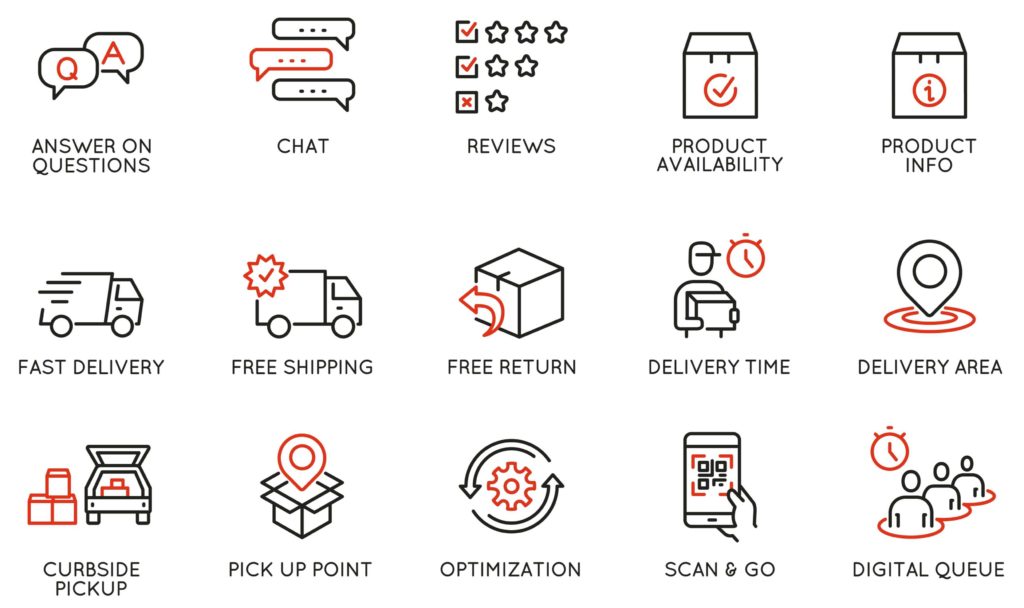
- Products
- Solutions
- Learn
- Partner
- Try Now
Did you know at least 30% of products ordered online are returned? Almost 92% of customers will buy something again if returns are easy. And, 67% of consumers check the returns page before making a purchase.
If you run a business, especially a delivery business or an eCommerce business that sells and ships products, the current returns policy that you have in place could be helping you gain or lose more customers.
A successful returns management policy that offers ample returns, in combination with low shipping prices across the board, has been shown to help businesses increase retention and customer loyalty and hence, more revenue.
In other words, by offering easy returns and low-cost shipping, you soothe the vast majority of your customers, ultimately leading to increased orders and improved customer satisfaction (which is the most important thing in any business).
Also, if you are repeatedly making mistakes in your delivery, it would be very hard for your business to survive in the long run. On the other hand, these mistakes are not made by choice, it is just that most businesses do not have the necessary tools to make an informed decision.
This is why it is important to have an organized returns management system in place.
What is Returns Management?

Returns management is an important part of the superior customer and business relationships because timely repair, replacement of damaged items, or credits for returned items are perceived as a part of good customer service.
Returns Management offers a solution to help companies achieve responsive customer service by implementing cost-efficient customer and return policies. The application is characterized by the following key features:
- Instant response to customers’ requests
- Traceability and overview
- Flexibility
- Automation of the return to vendor process
Returns Management Process

With Returns Management, customers are not the problem, but the problem lies in a lack of transparency, inefficient processes, and ignoring the customers and their needs.
An optimal customer experience does not end with the purchase. In order to optimize it, the entire process chain must be transparent and disruption-free of the customers. This requires not just loyalty.
A software-based returns process helps businesses to better know their customers. Hence, they can find out which carrier the customer prefers or whether they prefer a pickup at their front door.
Or, for example, whether they would like to exchange the goods and/or prefer a voucher for a returned product. Some customers prefer to receive a small rebate for goods that are slightly damaged.
A strategic, digitized returns management process and related customer communication contain great potential for generating new sales and standing out from the competition.
It is of quite critical importance not to isolate the returns management at the company because, strategically positioned, almost the entire company can profit from it.
The Customer is Not the Problem
The returns problem is becoming bigger and bigger for many businesses.
The e-commerce industry is booming. The costs for shippers are increasing heavily. At the same time, the competition for online merchants is intensifying on the internet because not only the satisfaction with the product but also with the returns processing is very important for online customers.
If it is complicated, they will buy from another provider with better service. Thus, companies require a modern strategy for handling returns.
In the past, they have generally been regarded as a “necessary evil”: Because, even in the case of moderate returns rates, enormous costs are incurred and the subsequent related strategies and activities are generally targeted exclusively to cost reduction through returns prevention.
This limited perspective damages online dealers: Outdated strategies, rigid processes, and isolated software solutions prevent the full exploitation of the existing potential.
This is even more confusing because online merchants are accustomed to optimizing all aspects of their business with sophisticated methods and tools – from marketing to appeal to customers to conversion optimization.
They like to rely only too much on their external fulfillment which nonetheless does not help them to stand out from the competition.
If they establish the management of returns as strategic components, merchants not only save costs but rather improve customer loyalty and tap the additional potential.
Does Your Company Have a Transparent Returns Strategy?

Identify the possibilities for your Returns Management:
Answer the following 7 questions and count how often you have ticked “No” or “Don’t Know”.
| Yes | No | Don’t Know | |
| Do you know your return rate in the complete number of units? | |||
| Is your returns process made to create a positive customer experience – through transparency, speed, and convenience? | |||
| Do your customers evaluate your company’s returns practices positively? | |||
| Does your business profit from your returns strategy? | |||
| Are the returns processes automated to the greatest extent possible? |
Now assess your answers here:
- 0 – 2 times No/Don’t Know: Your company is on a very good path towards smart returns management.
- 3 – 5 times No/Don’t Know: There is a need to take action.
- 6 – 7 times No/Don’t Know: Your organization doesn’t use the potential and is running the risk of losing customers and sacrificing its competitive position.
How to Make the Most Out of Returns and Exchanges

1. Collect Data in an automatically via a digital infrastructure
Investigate the solid reasons for the return. Get feedback regarding the respective customer’s satisfaction with the returns process. Ask about the satisfaction with the delivery service as well as with the product. Analyze the relationship between the central demographic factors such as gender and age to the collected data.
Breakdown of the Types of Returns
Find out how the returns are allocated across the four types of returns:
- A-returns: The returned goods are in their original new condition and can immediately be resold
- B-returns: Small-scale rectifications of the goods or packaging are required
- C-returns: Large-scale defects which make processing for sale as new goods uneconomical and thus are placed on secondary markets
- D-returns: Major defects make it impossible to process the goods and resell them.
When you find out these data, you will be able to refine your measures in a well-founded manner and adapt them in order to attain cost savings as well as new sales sources.
Collecting and Evaluating Central Returns Key Indicators
For ongoing results and success management, measure all KPIs which are relevant for returns: Returns rate in absolute unit figures, returns cycle time, customer satisfaction, number of times shopping basket purchases were discontinued, conversion rate as well as individual key indicators.
2. Know Your Customers and Their Needs
Modern consumers are demanding and most of them are spoiled. With regards to the issues of convenience, speed, and transparency, many companies have set new standards. Based on these, online merchants must measure themselves.
Customer loyalty is being created increasingly through perfect customer service and less and less via a brand appeal. Whoever knows their customers and can address and respond to their needs in a personalized manner can assert themselves in competition.
3. Develop a Returns Strategy with Preventative Measure
The take-back of goods generates high costs. Many online merchants thus focus almost exclusively on cost reduction. For them, the focus is above all on the reduction of the rate through the prevention of returns. Conversely, a strategic returns management also offers additional options in order to handle returns in a financially advantageous manner and to tap the potential lying therein.
The prevention is a preventative strategy in order to discourage potential returners from their intent and to reduce the returns rate. For this, targeted incentives are created via compensation. Example: The buyer receives financial compensation if he foregoes a return. Alternatively, the return expenditures are increased through time, financial or emotional obstacles. This can occur, for example, by restricting the payment options or by tightening the return policies.
4. Ensure Automation and Transparency: Internally as well as Externally
At many e-commerce companies, a return slip is enclosed with the shipment.
Particularly in the fashion segment, the return slip enclosed with the return is still the standard.
This is symbolic of the approach to the return phenomenon: Many companies shy away from embracing new paths for returns. They fear that new processes will result in worse customer service.
In this context, precisely this type of return shipment often results in rigid and non-transparent processes. In addition to the detrimental ramifications on customer satisfaction and the creation of higher costs, there is a lack of above all transparency.
Thus, the merchant often does not even know that a return is on the way and must even then physically unpack them upon their receipt and inspect them based upon the return slip.
Only then the customer can count on a refund – which is complicated and, due to our digitalized world, seems anachronistic. Today, software platforms offer flexible and customer-friendly approaches for handling a complaint or return.
This is How to Make Returns Management Intelligent

The return strategies addressed in this blog show that skillful returns management can generate many positive effects.
If one ignores the possibilities lying therein and stubbornly holds fast to old processes and rigid, inflexible approaches, the company not only misses out on opportunities for additional sales. Strategies that are inefficient and customer-unfriendly lower customer loyalty and customers leave.
On the other hand, through a comprehensive returns management approach, processes can be optimized and customer relationships can be substantially improved for one’s own benefit through higher customer satisfaction.
In order to increase this potential, one must strategically address the phenomenon of the return:
- Build a platform that specializes in returns. By doing so, you will realize a transparent returns process. At the same time, you will generate revenue.
- Collect data and knowledge regarding your customers and find out what their needs are
- Develop a returns strategy which focuses on your customers’ needs
In order to do this strategically, you can make use of Tookan’s intelligent returns management solution. Tookan will provide you with strategies and sensible measures to implement which are also transparent and enjoyable to use.
Automate the Returns Process, Increase Customer Satisfaction, and Lower Costs.
Tookan provides you with a smart returns management solution for optimized returns processes. Tookan will convert returns into a transparent customer experience. Through satisfied customers, you will sustainably generate sales and, at the same time, save costs through automation.
Through Returns, you will improve customer loyalty, strengthen your competitive position and tap new sales potential. Make your returns management intelligent with Tookan.
Subscribe to stay ahead with the latest updates and entrepreneurial insights!

Subscribe to our newsletter
Get access to the latest industry & product insights.





















